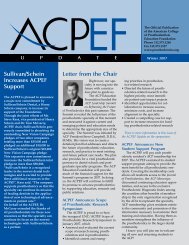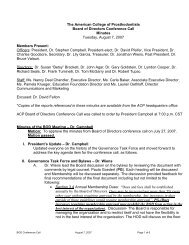PROSTHODONTICS - American College of Prosthodontists
PROSTHODONTICS - American College of Prosthodontists
PROSTHODONTICS - American College of Prosthodontists
You also want an ePaper? Increase the reach of your titles
YUMPU automatically turns print PDFs into web optimized ePapers that Google loves.
TOPICS OF INTERESTClassification System forComplete EdentulismThomas J. McGamy, DDS51hthurNimmo, DDS: James F. Skiba, DDS?Robert H. Ahlstrom, DDS, Christopher R. Smith, DDS,'and Jack H. Koumjian, DDS, MSD'The <strong>American</strong> <strong>College</strong> <strong>of</strong> <strong>Prosthodontists</strong> has developed a classification system for completeedentulism based on diagnostic findings. These guidelines may help practitioners determineappropriate treatments for their patients. Four categories are defined, ranging from Class I to ClassIV, with Class I representing an uncomplicated clinical situation and a Class IV patient representingthe most complex and higher-risk situation. Each class is differentiated by specific diagnosticcriteria. This system is designed for use by dental pr<strong>of</strong>essionals who are involved in the diagnosis <strong>of</strong>patients requiring treatment for complete edentulism. Potential benefits <strong>of</strong> the system include: 1)better patient care, 2) improved pr<strong>of</strong>essional communication, 3) more appropriate insurancereimbursement, 4) a better screening tool to assist dental school admission clinics, and 5)standardized criteria for outcomes assessment.J Prosthod 1999;8:27-39. Copyright 0 7999 by The <strong>American</strong> <strong>College</strong> <strong>of</strong> <strong>Prosthodontists</strong>.INDEX WORDS: complete dentures, diagnosis, treatment planning, prosthodontics, dentaleducation, graduate dental education, outcomes assessment, quality assurance, treatment outcomesOMPLETELY EDE,WLOUS PATIEhTS ex-C hibit a broad range <strong>of</strong> physical variations andhealth concerns. Classifying all edentulous patientsas a single diagnostic group is insensitive to themultiple levels <strong>of</strong> physical variation and the differingtreatment procedures required to restore functionand comfort. A graduated classification <strong>of</strong> completeedentulism has been developed that descri bPsvarying levels <strong>of</strong> loss <strong>of</strong> denture-supporting structures.This article defines complete edentulism as follows:the physical state <strong>of</strong> the jaw(s) following removal'Private pactice, Oklahoma Ciy, OK.2Projsjor and firedor <strong>of</strong>rmplant Dentistly, Department oJRaloratilieDentistv, UniL'ewip <strong>of</strong>Detrait Mery School <strong>of</strong> Lkntistv, Iletmit, ~2.11j'Pnvate practim, hfontontclair, iVJ4Priaatepractice, Reno, AT?-"-Pnvatepl-actice, San Antonio, TX.6Clinical Projtsw, Department $Restorative DentijQ, UCSF SchoolojDentisty andPricate Practice, Palo Alto, CA.ilzwptedJanuay 21,1999.Presented at the Annual Session <strong>of</strong>the Adcan Coliege <strong>of</strong> Prosthodoiitistsin Orlando, FL, Navember5,1997.Fun& lg The h i a n Colleze oJPmsthhodontis~.CnrresfnmdPnce to: Thomas J. McGaq DDS, 4320 McAulq Boubvard,Oklahoma Cab, OK 73120.Co&yright 0 1999 b The <strong>American</strong> Coliege ojPmsthodontists10.59-94 lX~~9i~80~-~OO5$5.00/0<strong>of</strong> all erupted teeth and the condition <strong>of</strong>the supportingstructures available for reconstructive or replacementtherapies. The condition <strong>of</strong> edentulism, for thepurpose <strong>of</strong> this article, is divided into four levelsaccording to specific diagnostic criteria.The absence <strong>of</strong> organized diagnostic criteria forcomplete edentulism has been a long-standing impedimentto effective care for patients. Recognition<strong>of</strong> the diverse nature, scope, and degree <strong>of</strong> completeedentulism, although thoroughly described in thedental literature, has not been organized to efficientlyguide dental educators, general dentists,prosthodontists, and third-party payers in providingthe appropriate treatment for each patient. A systemfor facilitating patient identification is needed toimprove patient treatment outcomes.The <strong>American</strong> <strong>College</strong> <strong>of</strong> <strong>Prosthodontists</strong> (ACP)recognized its responsibility to the public and thepr<strong>of</strong>ession to correct this dilemma. The Subcommitteeon Prosthodontic Classification was formedin 1995 and charged with developing classificationsystems for prosthodontic patients. Timelyimplementation <strong>of</strong> this system will benefit patients,clinicians, and educators. The classification systemfor complete edentulism is presented in the followingsections.Journal <strong>of</strong>Prosthodontics, Vol8, No 1 (Marcti)> 1999:H 27-39 272010 CDEL Re-recognition <strong>of</strong> the Specialty Report 146 <strong>of</strong> 279








